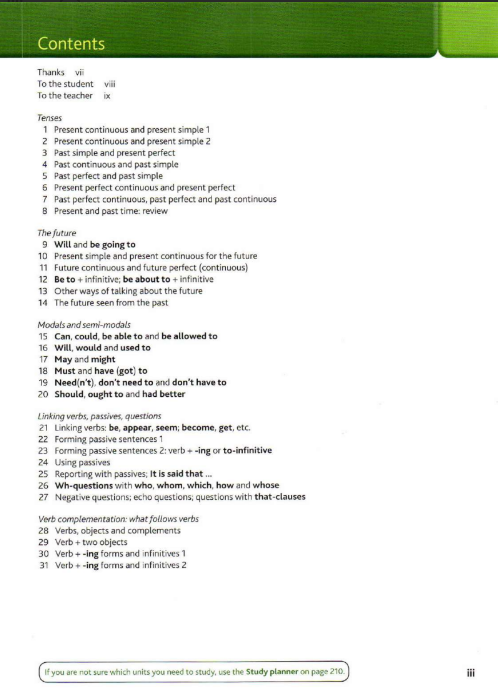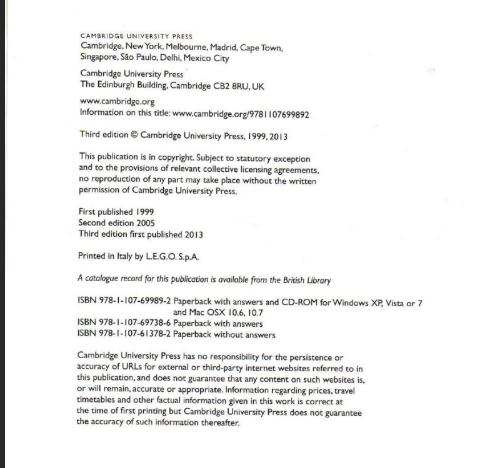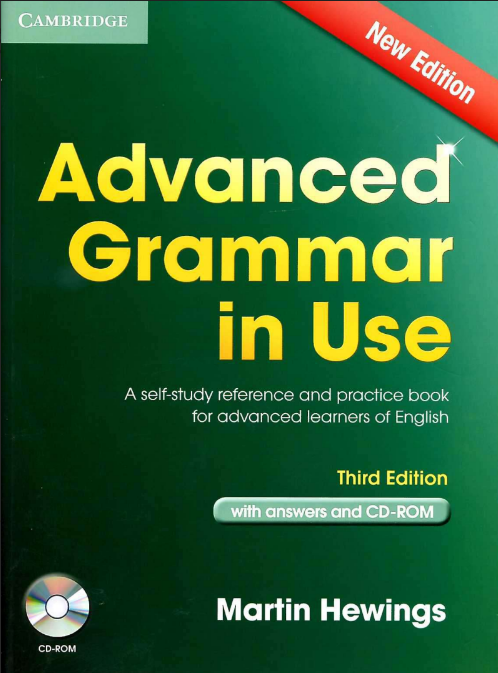


Page 2 (Copyright Information)** **CAMBRIDGE UNIVERSITY PRESS** Cambridge, New York, Melbourne, Madrid, Cape Town, Singapore, São Paulo, Delhi, Mexico City Cambridge University Press The Edinburgh Building, Cambridge CB2 8RU, UK www.cambridge.org Information on this title: www.cambridge.org/9781107699892 Third edition © Cambridge University Press, 1999, 2013 This publication is in copyright. Subject to statutory exception and to the provisions of relevant collective licensing agreements, no reproduction of any part may take place without the written permission of Cambridge University Press. First published 1999 Second edition 2005 Third edition first published 2013 Printed in Italy by L.E.G.O. S.p.A. A catalogue record for this publication is available from the British Library ISBN 978-1-107-69989-2 Paperback with answers and CD-ROM for Windows XP, Vista or 7 and Mac OSX 10.6, 10.7 ISBN 978-1-107-69738-6 Paperback without answers ISBN 978-1-107-61378-1 Paperback without answers Cambridge University Press has no responsibility for the persistence or accuracy of URLs for external or third-party internet websites referred to in this publication, and does not guarantee that any content on such websites is, or will remain, accurate or appropriate. Information regarding prices, travel timetables and other factual information given in this work is correct at the time of first printing but Cambridge University Press does not guarantee the accuracy of such information thereafter. **Image 2: Pages 2 & 3 (Table of Contents)** **Contents** Thanks vii To the student viii To the teacher ix Tenses 1 Present continuous and present simple 1 2 Present continuous and present simple 2 3 Past simple and present perfect 4 Past continuous and past simple 5 Past perfect and past simple 6 Past perfect continuous and present perfect 7 Past perfect continuous, past perfect and past continuous 8 Present and past time: review The future 9 Will and be going to 10 Present simple and present continuous for the future 11 Future continuous and future perfect (continuous) 12 Be to + infinitive; be about to + infinitive 13 Other ways of talking about the future 14 The future seen from the past Modals and semi-modals 15 Can, could, be able to and be allowed to 16 Will, would and used to 17 May and might 18 Must and have (got) to 19 Need(n’t), don’t need to and don’t have to 20 Should, ought to and had better Linking verbs, passives, questions 21 Linking verbs: be, appear, seem, become, get, etc. 22 Forming passive sentences 1 23 Forming passive sentences 2: verb –ing or to-infinitive 24 Using passives 25 Reporting with passives: it is said that… 26 Two-questions with who, whom, which, how and whose 27 Negative questions; echo questions; questions with that-clauses Verb complements: what follows verbs 28 Verbs, objects and complements 29 Verb + two objects 30 Verb + -ing forms and infinitives 1 31 Verb + -ing forms and infinitives 2 Reporting 32 Reporting people’s words and thoughts 33 Reporting statements: that-clauses 34 Verb + wh-clause 35 Tense choice in reporting 36 Reporting offers, suggestions, orders, intentions, etc. 37 Modal verbs in reporting 38 Reporting what people say using nouns and adjectives 39 Should in that-clauses; the present subjunctive Nouns 40 Agreement between subject and verb 1 41 Agreement between subject and verb 2 42 Agreement between subject and verb 3 43 Compound nouns and noun phrases Articles, determiners and quantifiers 44 A / an and one 45 A / an, the and zero article 1 46 A / an, the and zero article 2 47 A / an, the and zero article 3 48 Some and any 49 No, none (of) and not any 50 Much (of), many (of), a lot of, lots (of), etc. 51 All (of), whole, every, each 52 Few, little, less, fewer Relative clauses and other types of clause 53 Relative pronouns 54 Other relative words: whose, when, whereby, etc. 55 Prepositions in relative clauses 56 Other ways of adding information to noun phrases 1: additional noun phrases, etc. 57 Other ways of adding information to noun phrases 2: prepositional phrases, etc. 58 Participle clauses with adverbial meaning 1 59 Participle clauses with adverbial meaning 2 Pronouns, substitution and leaving out words 60 Reflexive pronouns: herself, himself, themselves, etc. 61 One and ones 62 So and not as substitutes for clauses, etc. 63 Do so; such 64 More
**Thanks** I would like to thank all those who worked with me on the first two editions of Advanced Grammar in Use, in particular Jeanne McCarten and Alison Sharpe for their encouragement. Thanks also to my former colleagues and students in the English for International Students Unit at the University of Birmingham for their help and interest. For this third edition I am grateful to Colin McIntosh, Nora McDonald, Annabel Marriott, Sabina Sahni, Kevin Doherty, Andy George, Claire Cole and Janet Weller. Claire and Janet in particular have given me tremendous support in preparing the book and the accompanying CDROM. Thanks to Sophie Joyce, Sandy Nichols, Katie Mac Ian Mitchell and David Whamond for the illustrations and to Kamae Design for their work on the finished product. I would also like to thank Cambridge University Press for allowing me access to the Cambridge International Corpus. Many students and teachers sent me comments on the 2nd edition, and these have been very helpful in writing this new edition. Thank you all for taking the trouble to contact me. Finally, my thanks, as ever, to Suzanne, David and Ann. The authors and publishers acknowledge the following sources of photographs and are grateful for the permissions granted. p. 6: WithGod/Shutterstock; p. 11: Comstock Images/Thinkstock; p. 17: Thinkstock; p. 33: Image Source/ Glowimages; p. 39: Thinkstock; p. 109: Thinkstock; p. 114: Bildagentur RM/Glowimages. — **Image 2: Page: To the student** **To the student** **Who the book is for** Advanced Grammar in Use is for advanced students of English. It was written mainly as a self-study book, but might also be used in class with a teacher. **How the book is organised** There are 100 units in the book, each looking at a particular area of grammar. Some sections within each unit focus on the particular use of a grammatical pattern, such as will (e.g. will be travelling), others explore grammatical contrasts, such as whether to use would or used to, reporting past events, or when we use except or even for. The 100 units are grouped under a number of headings such as Tenses and The future, and you can find details of this in the Contents. Each unit consists of two pages. On the left-hand page are explanations and examples; on the right-hand page practice exercises. The letters next to each exercise show which section(s) of the left-hand page you need to understand to do that exercise. At the back of the book you will find a number of further sections. * Appendices (pages 202 and 204) provide further information about irregular verbs and passive verb forms. * Glossary (page 205) although terms to describe grammar have been kept to a minimum, some have been included, and you can find explanations of these terms in the Glossary. * Study planner (page 210) you can use the Study planner to help you decide which units you should study, or which parts of the Grammar reminder you should read first. * Grammar reminder (page 222) This is a reference-only section which presents basic knowledge on a number of areas of grammar. Relevant to that unit. Read these sections to refresh your understanding before you start work on the more advanced grammar points in the unit. * Additional exercises (page 240) If you want further practice of grammar points, follow the references at the bottom of the right-hand page of a unit. These will tell you which of the additional exercises to do next. * Keys (pages 251, 277 and 278) You can check your answers to the practice exercises, study planner and additional exercises in the keys. You will also find comments on some of the answers. * Index (pages 281 and 287) Use the index to help you find comments on the vocabulary or grammar you need. **How to use the book** It is not necessary to work through the units in order. If you know which grammar points you have difficulty with, go straight to the units that deal with them, using the Contents or Index to help you find the relevant unit. When you have found a unit to study, read through any related material in the Grammar reminder before you begin. You can use the units in a number of ways. You might study the explanations and examples first, do the exercises on the opposite page, check your answers in the Key to Exercises, and then look again at the explanations if you made any mistakes. If you just want to practise an area of grammar you think you already know, you could do the exercises first and then study the explanations for any you got wrong. You might of course simply use the book as a reference book without doing the exercises. **Corpus information** A corpus is a large collection of texts stored on a computer. In writing Advanced Grammar in Use, we have worked with the Cambridge International Corpus (CIC), a multi-million


